The Ultimate Guide on Where to Go Camping in France 2024
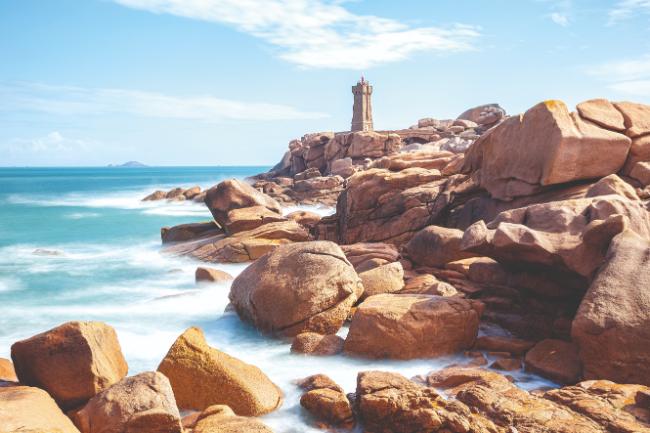
If you enjoy a camping holiday, France is hard to beat for richness and diversity: from the mountains to the coast, through shaded forests and lush green valleys, it provides everything lovers of the great outdoors could wish for ‘en vacances’.
For those seeking a relaxing break that embraces fresh air and open spaces, there are campsites galore to consider. And if you are travelling with kids, the choices are endless, both in terms of location and accommodation type.
Looking for a little culture, history or theme park fun? Why not give yourself the best of both worlds: enjoy the benefits of rural France on a campsite close to a town of your choice, then use your mobile home or tent as a base from which to explore?
But where to go? For inspiration, we present our selection of must-see holiday hotspots in six of the French regions with the most campsites. It’s impossible to decide which destinations in each of these regions are ‘the best’ all we aim to do here is present food for thought for all the family and wish you bonnes vacances!
NOUVELLE-AQUITAINE
As France’s largest region and boasting diverse paysages both coastal and mountainous, as well as stunning towns and villages, loads of family-friendly options and a superb array of gastronomic and wine delights, Nouvelle-Aquitaine is a camper’s paradise.
Bordeaux, capital of the Gironde department and France’s sixth largest city, is a strikingly elegant urban delight. It is home to the emblematic Cité du Vin (housed in a stunning building designed by Anouk Legendre and Nicolas Desmazières), which will teach you everything you need to know about wine history and winemaking, before you head out to notable vigneron hotbeds such as Saint-Émilion. Make the most of your time in the city with a quayside bike ride en famille before hunting down one of the city’s famed sweet treats, the canelé. Tick off must-see architectural wonders such as the grand Palais de la Bourse, the beautiful, photo-friendly Miroir d’Eau (water mirror) and Porte Cailhau, a 35m tall landmark integrated into the city walls.
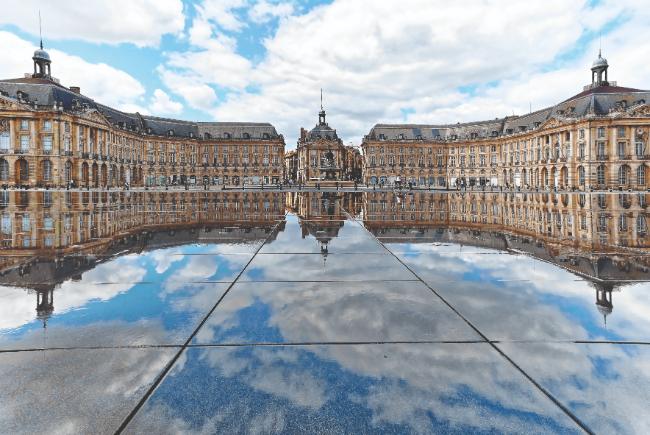
Bordeaux’ mesmerising Miroir d’Eau © shutterstock
The Bay of Arcachon
A great day trip from Bordeaux on the Atlantic seaboard – is a fine compendium of beaches and ocean views, sand dunes, typical architecture, pretty ports and oyster beds. For a spot of sightseeing or a great seafood meal, make a beeline for Cap Ferret (mount the 258 steps of this iconic Bay landmark if you dare) and the town of Arcachon, while the most intrepid will want to stomp up La Dune du Pilat, the famous 110m high sand mountain, for an eye-popping panoramic view don’t forget your camera!
Keeping it coastal, there’s no seaside resort quite like Biarritz in the heart of the Basque Country, which presents contrasting double appeal: the olde-worlde tourism charm of its refined hotels (none more so than the super-elegant Hôtel du Palais Biarritz built for Empress Eugénie) and the flocks of amateur and pro surfers keen to ride the crashing waves before enjoying the bustling bar scene or dabbling at the Lucien Barrière Group casino. It also provides plenty of relaxation options thanks to a raft of thalassotherapy and spa centres and several reputable golf courses.
Pau is a charming, characterful place to visit in the Pyrénées-Atlantiques department, a prefecture (administrative capital) that combines fine panoramic views of the Pyrenees mountains and no end of historic and architectural intrigue. Dive into the past with a tour of Château de Pau, the birthplace of Henri IV in 1553, that sits right in the heart of the city of note are the royal tapestries, lovely gardens, tower and famous dungeon. Elsewhere, grab a coffee on a terrasse along Boulevard des Pyrénées to admire the aforementioned ice-capped mountains and take a trip on the city’s cute funiculaire – there’s a trip every three minutes and it will take you down to (or up from) the main train station.
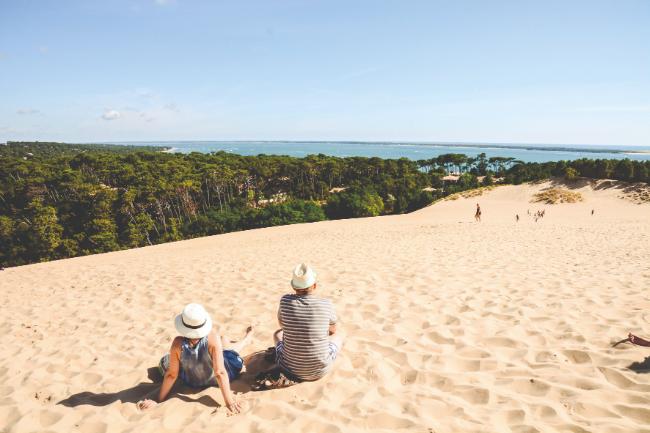
Climb the iconic Dune du Pilat © shutterstock
Vallée de la Dordogne
Snaking through lush countryside, the Dordogne river is one of France’s most appealing for those on the tourist trail, lined as it is with perched villages, superb water-based activities for all the family (from leisurely boat tours and kayaking to fishing, swimming and so much more), as well as some of the most spectacular villages in the whole country.
Don’t miss La Roque-Gageac, a riverside ‘troglodyte village’ in the Périgord Noir corner of Dordogne, just 12km from pretty Sarlat. Strolling through the village seemingly frozen in the Middle Ages, seek out the 14th-century Romanesque church before sampling and buying delicious local products at the farmers’ market held at the foot of the village every Friday morning from May to September. And for a truly memorable view of the village, head for the water on a gabarre boat tour.
Plus Beaux Villages lovers will also want to stop by Collonges-la-Rouge, the reddish-brick beauty where the association of France’s most stunning villages all began, while kids will love Le Gouffre de Padirac, a magical realm of caves.
Limoges is an often unheralded city destination, and an ideal day trip for campers in the region. The train station, built between 1924 and 1929, is amongst France’s most beguiling, while its fine porcelain heritage provides the chance both to learn and shop in style as the tourist board says, “the arts of fire deeply mark the identity of the city”. Start by snapping the monumental fountain adorning the beautiful mairie (town hall) before taking in the Musée national Adrien-Dubouché, which is dedicated to Limoges porcelain and the history of ceramics. The city is also blessed with many lovely green spaces and urban gardens in which to relax with a picnic and enjoy the flora and fauna.
What’s so appealing about the Marais Poitevin (which is located across sections of Vendée, Deux-Sèvres and Charente-Maritime in the historic Poitou province) is that the whole family will love exploring this expanse of navigable marshland with its network of canals framed by lush vegetation. Take your pick of transport modes, all of them leisurely: by foot, horseback (or donkey ride!), by bike or go-slow boats. Known locally as ‘Green Venice’, it offers a real back-in-time, slow tourism experience.
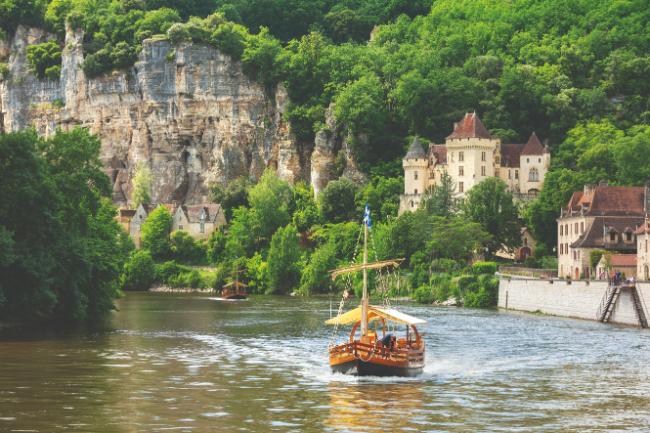
Sailing on the Dordogne river at La Roque-Gageac © shutterstock
From its idyllic restaurant and bar-lined bustling harbour side, whose entrance is neatly framed by two imposing towers, La Rochelle is a perfect day-out destination for anyone camping nearby. After a photo opportunity at the emblematic Grosse Horloge clock tower, explore the town’s ancient arcaded streets, lined with boutiques, or perhaps head out to sea for a magical boat trip to spot Fort Boyard or visit the nearby islands of Île de Ré, Aix and Oléron. For those without sea legs, little ones will love the hugely impressive aquarium, while cyclists can explore a section of the brilliantly maintained Vélodyssée route, which passes through the town.
Then everyone can unwind whilst tucking into a generously heaped platter of fruits de mer in one of the town’s many high-quality seafood restaurants. First stop on any visit to Poitiers should be the Romanesque architectural gem, the church of Notre-Dame la Grande, on Place Charles de Gaulle. Have your camera zoom ready to snap the magnificently sculpted western façade, deemed a masterpiece of religious art. Then step further back in to time to explore the Palace of the Counts of Poitou-Ducs d’Aquitaine, an amazing medieval keep in the Plantagenet style..
Ten kilometres north of the city is one of France’s best theme parks, Futuroscope – a winner for kids of all ages that combines hi-tech wizardry and thrilling rides. Lovers of comic strip story books called ‘the ninth art’, or bandes dessinées in French will find no better spot in the whole of France in which to indulge in their passion for the printed picture yarn than Angoulême (prefecture of the Charente department). It is home to both the Comic Books Museum and the annual get-together of like-minded comic lovers, called the Angoulême International Comics Festival. Meanwhile all around town you can spot brilliantly conceived murals, which can be ticked off on a ‘painted walls’ walking tour.
Nouvelle-Aquitaine tourist board www.nouvelle-aquitaine-tourisme.com/en
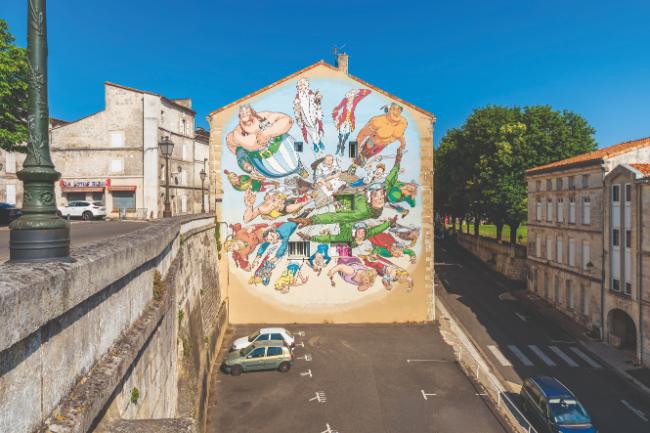
A huge mural in Angoulême dedicated to Astérix illustrator Albert Uderzo © shutterstock
OCCITANIE
Occitanie was formed in 2016 from the former regions of Languedoc-Roussillon and Midi-Pyrénées. Blessed with a rich variety of beautiful landscapes both coastal and inland, it is also famed for the locals’ passion for a lifestyle embracing great food and drink traditions… and innumerable pretty villages and historic towns.
Viewed from the A61 autoroute (it’s only 75 minutes from Toulouse), the sprawling Cité Médiévale de Carcassonne a citadel built in the 12th century and listed as a World Heritage Site by UNESCO in 1997 – is one of the most imposing and startling sights in all of France. While its 52 towers and ramparts set the aesthetic from afar, it’s once you pass through its gates that the real magic unfolds. Explore the charming streets and alleys where chic boutiques, bars and restaurants complete the unique visitor experience. Just 35 minutes northeast of Nîmes is where you will spot the most visited ancient monument in France, the majestic aqueduct Pont du Gard. Measuring 275m long and 49m high and featuring three tiers of arches, it was built in the 1st century AD to carry water across the Gardon river to what was then a Roman colony called Nemausus (present day Nîmes). It is an ideal spot for family bathing (it has a supervised play area and beach) while the immersive scenography at the nearby museum recounts the bridge’s construction. Little ones and adults alike will marvel at the ingenuity of Roman engineering!
From river valley to mountain high, reach for the stars (almost literally) with a vertiginous trip up Le Pic du Midi – Europe’s highest planetarium at an altitude of 2,877m dubbed ‘the balcony of the Pyrenees’. Accessed by cable car from La Mongie ski resort, there’s plenty to see and do: visit the Experiences museum, refuel at the restaurant, or enjoy stargazing nights with a meal and astronomical entertainment (booking ahead is advised).
A visit to the ‘pink city’ of Toulouse should be on everyone’s Occitanie wish- list, be they first-timers or repeat visitors. There’s so much to see and do, from UNESCO World Heritage sites Saint-Sernin Basilica and Hôtel-Dieu Saint- Jacques; to the Jacobin Convent, a gem of Southern French Gothic Art, and the cloisters and Augustine Museum; and the superb mansion, Hôtel d’Assézat. Afterwards, enjoy lunch on spectacular central place du Capitole or place Saint- Georges, where a hearty portion of local speciality cassoulet will set you up for more visits! For youngsters, a trip to the 2,500m² Cité de l’Espace is the next best thing to going into space.
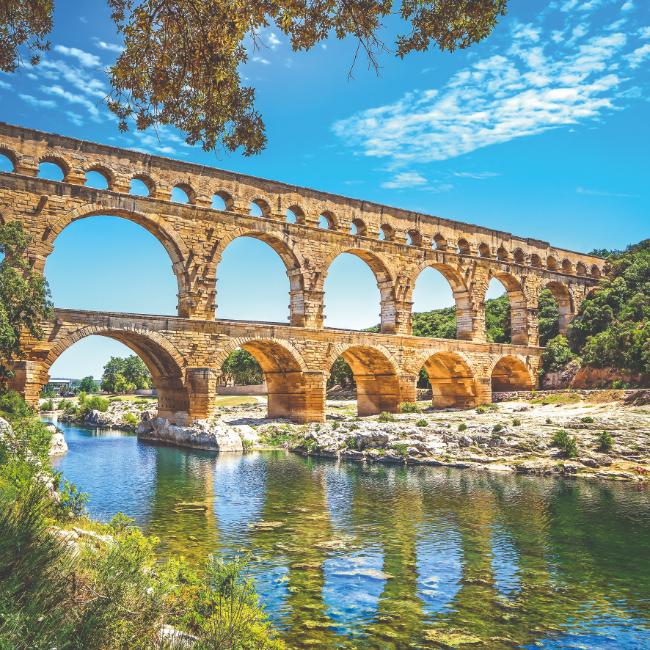
Pont du Gard © Shutterstock
For fans of wild nature, Gorges du Tarn (the Tarn river canyon) is hard to beat. Between Quézac (Lozère) and Le Rozier (Aveyron) there is a mindblowing 50km stretch of the snaking Tarn flanked by steep limestone cliffs to marvel at either from above via hiking trails and panoramic viewpoints, or below on the water (canoeing, swimming). Have your camera ready when you arrive in the medieval village of Sainte-Enimie, classified as a Plus Beau Village de France itself a great departure point for river-based fun.
Few Mediterranean ports are as vibrant and characterful as Sète in the Hérault department. With its canals, quays and small squares which have earned the port the nickname ‘Venice of Languedoc’ – as well as an array of cultural events such as the famous sea jousting festival (Escale à Sète, taking place from March 26 to April 1 this year) and an abundance of superb seafood culinary experiences, it is a key seaside destination in southern Occitanie.
Sigean, situated between Narbonne and Perpignan in Aude, is an unmissable destination for families holidaying on the coast of the former Languedoc-Roussillon region. The reason? Its wonderful African Animal Reserve, a ‘semi-natural’ animal park that is not only home to rhinos, hippos, lions, chimpanzees, giraffes and flamingos but also has an important scientific research and wildlife conservation programme.
Speaking of wildlife, the Camargue is a vast, magical area of saltwater lagoons, marshes, and freshwater lakes located between the Mediterranean and the Rhône delta, packed with exceptional biodiversity. IGP Camargue rice is grown on paddy fields, while black bulls, white horses and pink flamingos abound. Why not drop into a manades – a bull breeding farm run by the iconic gardians, or horseback bull herders.

Water Jousting performance during the St Louis festival in Sète © shutterstock
The 17th-century brainchild of Pierre-Paul Riquet, Louis XIV’s tax collector, the 240km Canal du Midi was an extraordinary feat of civil engineering, creating a waterway from Sète to Toulouse. Dreamy and green tourism has overtaken goods transport as its raison d’être, so gear up for a barge trip, bike ride or walk, taking in wine tastings, villages and top sites such as the restored Fonseranes Nine Locks.
Occitanie has dozens of stunning villages to explore: leave the campsite for the day and set your GPS for diamonds such as Conques, Cordes-sur-Ciel, Castelnau-de-Montmiral, Puycelsi, Penne, Bruniquel, Saint- Guilhem-le-Désert, Rocamadour and Saint-Cirq-Lapopie. Finally, the Hautes-Pyrénées, its most westerly, mountainous department, is super for summertime campers and hikers – choose from gentle routes through the rolling foothills and plains, or superb way-marked trails of the Louron valley, Gavarnie and Grand Tourmalet. You can spot tremendous flora and fauna when exploring by bike or on horseback. The thermal resort of Saint-Lary is an authentic Pyrenean village with all manner of family-friendly activities from climbing to archery. In short, Hautes-Pyrénées with its wildly spectacular backdrop, is a super adventure playground, whatever outdoor thrills you happen to be seeking.
Further information Occitanie tourist board www.visit-occitanie.com/en
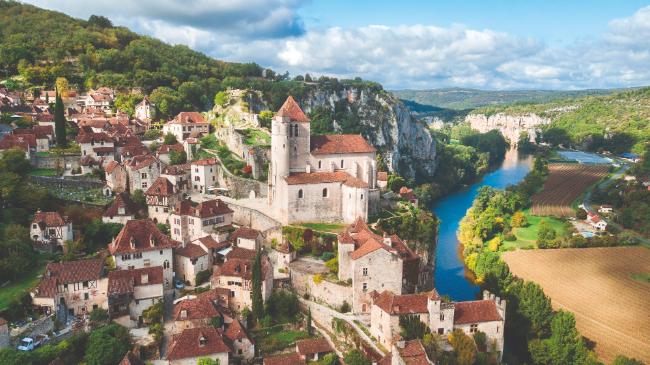
Plus Beau Village Saint-Cirq-Lapopie in the Lot department of Occitanie © shutterstock
AUVERGNE RHÔNE-ALPES
With its epic chain of volcanic mountains and the mighty Alps, this naturally blessed region is home to the departments of Ain, Allier, Ardèche, Cantal, Drôme, Haute- Loire, Haute-Savoie, Isère, Loire, Lyon Metropolis, Puy-de-Dôme, Rhône and Savoie.
Any list of great places to visit in this region should include the regional capital and France’s capital of gastronomy – Lyon, which is located at the meeting point of the Rhône and Saône rivers. Exploring its history of silk making, network of traboules (shortcuts linking streets through one or more buildings) in Vieux Lyon and the slopes of La Croix-Rousse hill, iconic Place Bellecour, with its equestrian statue of Louis XIV, the Fourvière panoramic viewpoint and indulging in its legendary bouchon gastronomy is just for starters…
Elsewhere, Mont Blanc is Europe’s highest point and the winter Alpine ski options are endless. But come summertime when campsites are calling you, ski resorts provide the superb facilities so beloved of skiers in winter, while the swathes of flower-filled meadows and grassy slopes lure hikers and mountain bikers.
Auvergne’s greenery is. unmatched and it has many superb natural regional parks. Puy de Dôme overlooks a range of 80 volcanoes that make up the Chaîne des Puys reach the top in just 15 minutes aboard the Panoramique des Dômes train. The Rhône-Alpes, meanwhile, boasts picture- postcard Lake Geneva and Lake Annecy, providing wonderful areas for campers to enjoy a summer break with a spot of boating, swimming and plenty of other watersports. However, for campers who enjoy visiting cities for the day, the region is blessed: well worth taking in are Saint-Étienne and Grenoble and the historic city of Clermont-Ferrand. And don’t miss pretty Le Puy-en-Velay, prefecture of the Haute-Loire department, or the fantastic Vulcania theme park, a kids’ favourite.
In terms of natural wonders, the Pont d’Arc is hard to beat. Ardèche, the department in which it is located, is a wonderful area for camping, with gorgeous riverside idylls (grab a kayak or canoe to explore the scenery). Then there’s the Chamonix glacier and the spa towns of Évian and Thonon, not forgetting the delightful Côtes du Rhône vineyards stretching from Vienne to Tournon.
Auvergne-Rhone-Alpes tourist board www.auvergnerhonealpes- tourisme.com/en
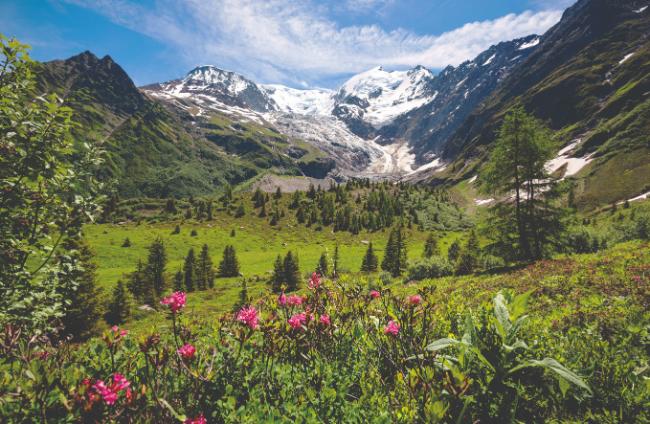
The alpine meadows come into bloom in spring and summer © shutterstock
BRITTANY
All channel- hopping visitors will have their unique Breton bucket-list, but here are some ideas for exploring urban delights and natural wonders in this rich and rugged region just a short ferry trip from the UK.
The capital Rennes is an historic gem packed with great markets and cultural events plus a lively student population. With its cobbled streets and buzzy café terraces, half-timbered houses and restful green spaces, it’s the perfect place for a day out.
Travelling via ferry at Saint-Malo? Stop among the granite ramparts and explore the quaint streets oozing charm, maritime tales and super boutiques and restaurants. Inland, the mythical forest of Brocéliande is the cradle of King Arthur’s tales and home to unspoilt countryside. Explore the forest trails en famille there are almost 200 signposted routes. For more history, head to the 1,000-year-old fortress town of Fougères in Ille-et-Vilaine, where the epic defensive complex of the castle is a sight to behold, or Carnac in the Quiberon Bay, where fields of menhirs (standing stones) and five lovely beaches combine for a great family escape. Coastal charm abounds, of course, from the beauty of the Pink Granite coast (photo op: Ploumanac’h lighthouse) to island gems such as Belle-Île-en-Mer and Bréhat, while villages such as Rochefort-en-Terre voted France’s favourite village in 2016-and riverside beauty Dinan are both adorable.
Brittany tourist board www.brittanytourism.com

Brittany’s rugged coastline © shutterstock
HAUTS-DE-FRANCE
Formed by the unification of the former Nord-Pas-de-Calais and Picardy regions in 2014, this is the northernmost region of France, where camping culture vultures, foodies and lovers of the great outdoors are in for a treat Lille, the eye-pleasing capital, provides plentiful appeal to day visitors, with ample opportunities to feed both the mind and the stomach with a diverse array of museums, cultural landmarks and a range of must-taste local culinary delights. The focal point is the beguiling and spacious Grand’Place (drop into the stunning courtyard of the Vieille Bourse), also known as Place du Général de Gaulle (Charles de Gaulle was born in Lille in 1890). Beyond this, Vieux Lille is a rabbit warren of quaint streets, dotted with estaminets (characterful old taverns) serving up hearty local cuisine such as carbonnade flamande, a beef stew served with frites. Bucket-list spots to visit include the Musée de l’Hospice Comtesse and the Palais des Beaux-Arts, while other unmissable Hauts-de-France towns for history addicts are Beauvais, Laon and Arras. La Piscine in Roubaix, just a short hop from Lille, is a magnificent museum installed on the site of the former Art Deco municipal baths, with stunning sculptures standing sentry over the pool and an impressive roster of temporary exhibitions.
For an even larger immersion into artistic endeavour, head over to Lens, where the Louvre’s regional sister museum has breathed life into this former hub of coal mining. Open since December 2012, the main focal point of this cultural behemoth is the 120m-long Galerie du Temps, displaying over 200 artworks spanning 5,000 years.
Chantilly castle, one of France’s architectural crown jewels, is located in the Oise department and is equally appealing for equestrians and art lovers thanks to its stables and sublime Condé Museum, housing the second largest collection of antique art outside the Louvre.
With its hortillonnages – a labyrinth of ‘floating’ gardens, Jules Verne’s house and bustling Saint-Leu restaurant quarter, Amiens already has much to offer. But the most critical visit to be made here is the epic Notre-Dame cathedral, the largest Gothic cathedral in the world.
The ferry port of Calais is often seen in the rear-view by those whizzing off elsewhere in France on holiday but it really is worth a visit in its own right. There’s lots of culture to explore: the City of Lace and Fashion; the Fine Arts Museum located opposite Richelieu Park; the stunning belfry adjoining the Town Hall; and Auguste Rodin’s statue of the Burghers of Calais the city’s most photographed monument.
Hauts-de-France has its fair share of gorgeous villages, among the finest being picture-postcard Gerberoy, a vision of half-timbered houses and wisteria-covered walls. Campers visiting in June will love the spectacular Fête de la Rose (rose festival).

The Louvre-Lens is an art museum located in Lens, Pas-de-Calais © shutterstock
To enjoy the great French outdoors writ large, head for the Bay of Somme, a Grand Site de France and a calm haven for a quiet stroll, bird watching and even sand- yachting-all great for kids who love the sea air.
Another coastal magnet is Les Deux-Caps, a wondrous stretch of white cliff-framed beaches on the famed Côte d’Opale (Opal Coast). With hiking trails and heritage gems to explore, fun activities and stunning views, it’s a family-friendly destination just half an hour from Calais and the vibrant port town of Boulogne-sur-Mer, which is home to the fantastic and unmissable Nausicaá, Europe’s biggest aquarium.
No family trip to Picardy, in Hauts-de-France, is complete without a day or two at the Parc Astérix, the amusement park dedicated to France’s most iconic comic strip books. Over 40 rides bring thrills and humour in abundance for kids (and adults!) of all ages.
Hauts-de-France tourist board www.french-weekendbreaks. co.uk

Aerial view of the Bay of Somme © shutterstock
PROVENCE-ALPES CÔTE D’AZUR
The epitome of sunny southern French living, PACA – also known as Région Sud – combines the glitzy Riviera with an idyllic hinterland.
Boasting striking hilltop villages such as Saint-Paul de Vence and Èze, lavender fields all around (drop into villages such as Sault) and the sparkling Mediterranean coastline with its spectacular range of elegant resorts and beautiful beaches (Cannes! Antibes!), Provence-Alpes- Côte d’Azur truly is akin to holiday heaven on earth little wonder this dazzling region draws visitors from all over the world. In peak season it gets very busy but you can find a little peace away from the summertime throng-families with a passion for the outdoors should head to the Gorges du Verdon, France’s answer to the Grand Canyon. Accessed via a breathtaking corniche route around the rim of the gorge, the area of outstanding beauty is a haven for intrepid hikers and has lots of safe river swimming and canoeing opportunities.
Love a little history and city exploration on holiday? Check out the Roman ruins in Arles (Bouches-du-Rhône) or culturally rich Avignon (Vaucluse) then explore the region’s two major cities, Marseille and Nice, before taking your pick of small coastal gems such as Bormes-les-Mimosas and Saint-Tropez (both in the Var department).
Provence-Alpes-Côte d’Azur tourist board provence-alpes-cotedazur.com/en
From France Today Magazine
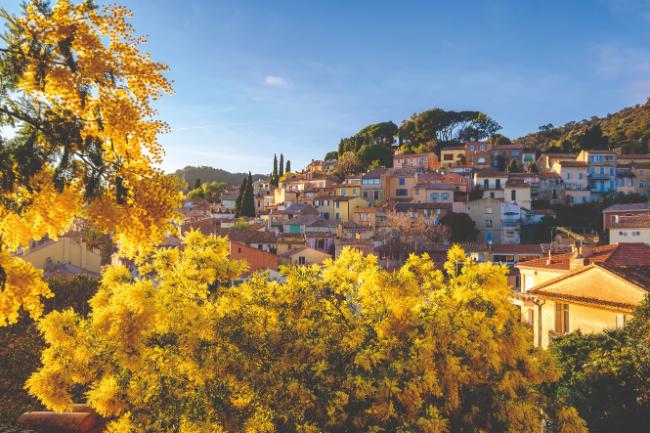
Beautiful Bormes-les-Mimosas epitomises the south of France © shutterstock
Lead photo credit : Brittany's rugged coastline © shutterstock
Share to: Facebook Twitter LinkedIn Email
More in camping, Camping in France, campsites, outdoors, travel guide
Leave a reply
Your email address will not be published. Required fields are marked *



